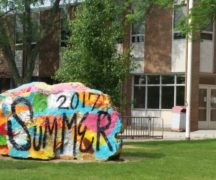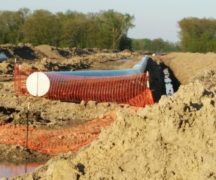By JAN LARSON McLAUGHLIN
BG Independent News
Bowling Green City Schools needs a new high school, according to a committee charged with finding the best solution for the district’s aging facilities.
After the high school is completed, the next priority is to build either one consolidated elementary or two new elementaries.
The proposed plan was announced Wednesday evening during a meeting for the community. It came after seven months of meetings with a facility advisory committee made up of local representatives of business, agriculture, community groups, parents, alumni and school officials.
“We didn’t want the choir,” Superintendent Francis Scruci said of the makeup of the committee. “We wanted to make sure the community felt engaged.”
“Our facilities are in need of attention, and we’ve had several failed opportunities on the ballot,” Scruci said.
The committee is hoping this time will be different.
“I want to stress this is a community effort,” Scruci said.
Why now?
Dan Obrynba, of Fanning Howey architectural firm, listed the top reasons the committee decided now is the time to build.
First, the buildings are ancient in school years. The high school, Conneaut and Kenwood elementaries were built more than half a century ago – and learning has evolved and left those buildings behind.
Second is the marketability of the schools for families searching for the best district for their children. “Parents have options,” and right now Bowling Green’s facilities don’t rank high, Obrynba said.
Third, community pride, which dips a bit each time a building issue fails at the ballot.
And finally, building costs, which continue to go up. Inflation is eating away at how much the district can do, Obrynba said.
What’s the plan?
The facilities advisory committee reached a strong consensus that a new high school is necessary. And the best route to do that is to build the new building, possibly on the west side of the school parking lot, while kids continue learning in the current high school. The existing gyms may be saved for practice space, as well as the music rooms and vo-ag area.
Construction in the new space could be completed in 24 to 28 months, whereas it could take up to 40 months to do a partial demolition of the existing school to build new space.
Advisory committee member Richard Strow, a representative of the agricultural community, stressed that a new high school is needed.
“The high school we have today is the same high school I graduated from in 1977,” Strow said.
But no consensus could be reached on the elementary buildings – other than an agreement that the current buildings had outlived their usefulness. The committee reached a 50-50 split on the two top options of building one consolidated elementary or building two new elementaries on the site of Conneaut and Kenwood schools. Crim would be used for central administration, preschool and possibly kindergarten, and special needs students.
“This was a complete and total shock,” Strow said of the even split on one or two elementaries.
By addressing the facilities in phases, the committee is hoping the public will rally around the new high school, then may have time to reach a consensus on the elementary issue, Strow said.
Ballpark costs?
The estimated costs vary depending on whether the buildings are designed for the 2015 enrollment projections, or the 2022 enrollment realities.
Here are some rough figures (some taken from the advisory committee’s data on the district’s website):
- Brand new high school: $48.2 million to $58 million, depending on many variables.
- Consolidated elementary at current enrollment: $34.6 million
- Consolidated elementary at 2015 projections: $47.4 million
- Two new elementary schools at current enrollment: $42 million
- Two new elementary schools using 2015 projections: $50.8 million
The committee agreed by an 87% vote to not go with Ohio Facilities Construction Commission support. That decision was based on the fact that the building projects would have to follow strict OFCC guidelines, would have potentially higher costs, less money would be available from the state than originally expected, and funding would be at least eight years away.
When are we talking?
Because of the big price tag – which could reach $100 million – the committee decided by a vote of 65% that the new buildings should be phased in rather than done all at once.
“We would like to move forward on the high school first,” Strow said, “That’s the place where the biggest need is now.”
What about the elementaries? That remains unknown. But Strow said the district will have the middle school paid off toward the end of the decade – so that may be a good time to start the second phase.
By then, Strow said, the district may have a better grasp of its enrollment projections, and may have a consensus on one or two elementaries.
Building histories and futures
The district’s enrollment has dropped by 312 students since 2015 when the district had 2,914 students, explained committee member Shelly Ruehl, parent of three BGHS graduates and administrator of Brookdale Senior Living.
Kenwood Elementary is the oldest, being built in 1953, followed by Conneaut in 1954, and Crim in 1957. The middle school is relatively new and would need only minor renovations according to the plan. But replacing the high school, which was built in 1963, was deemed most critical.
Ruehl talked about the “very concerning” issues seen during tours of the school buildings. In some schools, janitor closets are being used for instruction. The technology gaps are cavernous.
“Our teachers and administrators are being really creative,” she said.
The committee came to a 99% consensus that the buildings needed to be upgraded.
Teacher, principal and student perspectives
When Brynna Gaines, a senior and student athlete, travels to several other school districts, the differences are glaring. Those schools don’t have areas that are sweltering hot or freezing cold. They have classrooms with open designs, and new technology. They don’t have areas that stink of steam and mold, Gaines said.
“Our kids don’t have pride in our facility,” Principal Dan Black said.
Black listed off some of the high school building’s deficiencies:
- ADA compliance, with only one ADA restroom and one elevator.
- Science rooms without access to water and gas.
- Constant steam pipe leaks. A locker room was condemned five years ago after steam leaks led to the floor collapsing.
- Teachers are trying to teach for the future with technology of the past.
- Room size issues.
- Shift in teaching/learning styles that the building can’t accommodate.
- Lack of outlets in classrooms, which causes problems since all students now use Chromebooks.
“We’re trying to prepare kids for the future, while we’re stuck in a building built in 1963,” Black said.
Every summer Black gets calls from parents moving to the region, who want a tour of the high school.
“When you look at the facility, it’s tough to sell it,” he said. “They can go down the road in any direction” and find a district with new buildings.
High school teachers Cara Maxey and Stephanie Conway, who are also parents of district students, talked about the deficiencies at their building. The school falls far short of providing 21st century learning. Classrooms should be student-centered – which the current high school does not allow, Maxey said.
Teachers at all the school buildings were asked to show their preferences between traditional, transitional and transformational classrooms, Conway said. They overwhelmingly supported a blend of transitional and transformational.
What’s next?
Anyone wanting a tour of the high school may stop by on March 17, at 7 p.m., Black said.
Another public meeting on the proposed facilities plan will be held March 22, at 6 p.m., in the Performing Arts Center.
The advisory committee hopes to make a recommendation to the school board in April or May. If the board decides to move ahead on a new high school, a bond issue could be placed on the November ballot.





